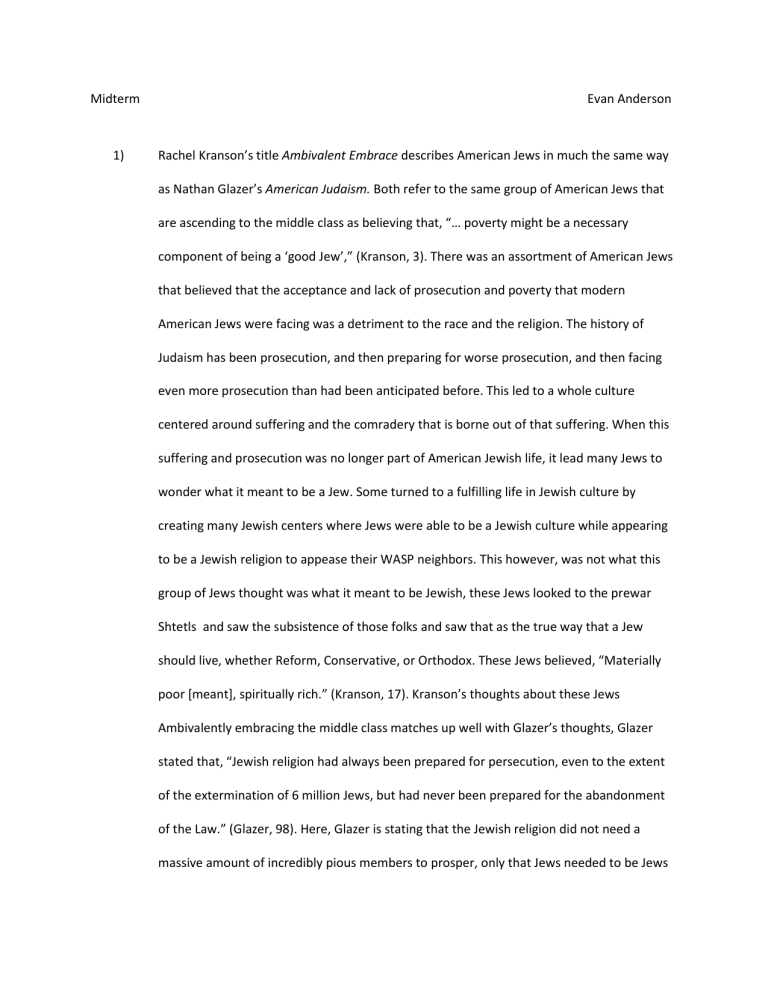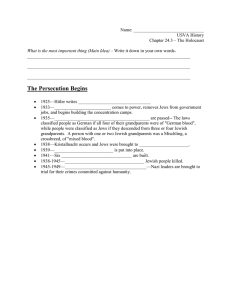
Midterm 1) Evan Anderson Rachel Kranson’s title Ambivalent Embrace describes American Jews in much the same way as Nathan Glazer’s American Judaism. Both refer to the same group of American Jews that are ascending to the middle class as believing that, “… poverty might be a necessary component of being a ‘good Jew’,” (Kranson, 3). There was an assortment of American Jews that believed that the acceptance and lack of prosecution and poverty that modern American Jews were facing was a detriment to the race and the religion. The history of Judaism has been prosecution, and then preparing for worse prosecution, and then facing even more prosecution than had been anticipated before. This led to a whole culture centered around suffering and the comradery that is borne out of that suffering. When this suffering and prosecution was no longer part of American Jewish life, it lead many Jews to wonder what it meant to be a Jew. Some turned to a fulfilling life in Jewish culture by creating many Jewish centers where Jews were able to be a Jewish culture while appearing to be a Jewish religion to appease their WASP neighbors. This however, was not what this group of Jews thought was what it meant to be Jewish, these Jews looked to the prewar Shtetls and saw the subsistence of those folks and saw that as the true way that a Jew should live, whether Reform, Conservative, or Orthodox. These Jews believed, “Materially poor [meant], spiritually rich.” (Kranson, 17). Kranson’s thoughts about these Jews Ambivalently embracing the middle class matches up well with Glazer’s thoughts, Glazer stated that, “Jewish religion had always been prepared for persecution, even to the extent of the extermination of 6 million Jews, but had never been prepared for the abandonment of the Law.” (Glazer, 98). Here, Glazer is stating that the Jewish religion did not need a massive amount of incredibly pious members to prosper, only that Jews needed to be Jews for the religion to survive, Kranson is stating that Jews were no longer Jews if they were not poor. Since being poor brought Jews together into a common situation, thus creating Jewish culture that ended up being Jewishness itself. Without a lack of prosperity Jews could not be Jewish, since being Jewish meant to be poor and have inherent communal interests, rather than capitol interests. Kranson’s thesis about anxiety coincide with Glazer’s assessment of postwar American Jews being Ambivalent towards their newfound grace in the eyes of the American public. Both authors observe American Jewry being eager to ascend as well as seeing that ascension as bittersweet, as if they were about to lose a facet of their lives that had defined them for millenia. 3) The story of the Four Chaplains is a story of interfaith America making a sacrifice together for the greater good, to save four lives those four chaplains sacrificed their own, and went down with the sinking ship while they all prayed together. This was a message to midcentury America that there was a change in the religious tide. The singular faith Prewar America had suddenly become the Tri-Faith America that Kevin Schultz writes about. The inclusiveness of Jews and Catholics into what could be thought of as American was the great progressive movement of the midcentury. When Jews, Catholics, and Protestants could be on a level playing field was what seemed progressive to Americans in the 40’s and 50’s. Today this is not seen nearly as progressive. It seems as though Americans begrudgingly granted the right of Jews and Catholics to be seen as human, these days it would seem bigoted and inhuman to regard any foreign idea as less valuable than your own held beliefs. The emergence of Jews and Catholics into acceptance does not seem progressive to us because we have never seen any message other than acceptance, more like celebration of others over celebration of ourselves. 4) Kevin Schultz and Noah Feldman both tell us how the Protestant nature of America is the greatest factor in the acceptance and allowance of other religions. Feldman’s The Triumphant Decline of the WASP helps us realize that the birth of America was only because the first Protestants in this country were so overwhelmingly supportive of freedom of religion that they were willing to die for it. The protestant founders of the country were so engrossed in the idea of equality and freedom that they gave the ability to ascend to every American, no matter the religion. The very basis of Protestantism was inclusion, relinquishing power to anyone qualified, no matter race or religion, is what led to post-Holocaust America being so inclusive. The Protestant idea of “Faith saves” is what allows anyone from anywhere to be saved if they believe, this idea extends to political ends. If a Jewish boy wishes to be a supreme court judge and is willing to serve to the best of his ability, he will be allowed to serve. In Schultz’s Tri-Faith America Protestant, Jewish, and Catholic Chaplains work together to support American troops on bases all around the world. This gives allows the American public to see this support and see it as an example of the good that can come out of wartime, the necessary evil of war can give life to true good. The protestant idea of inclusivity and tolerance is the only thing that could allowed the acceptance of others. Since Protestants were the overwhelming majority, it would have been easy for them to deny all others and stay in power as long as they wished. The fact is that protestants were the only ones that could have voted themselves out of power. Since there are fewer protestants in power now the only explanation is that the idea of inclusivity was a success, and protestants were able to hold up to their own ideals.



